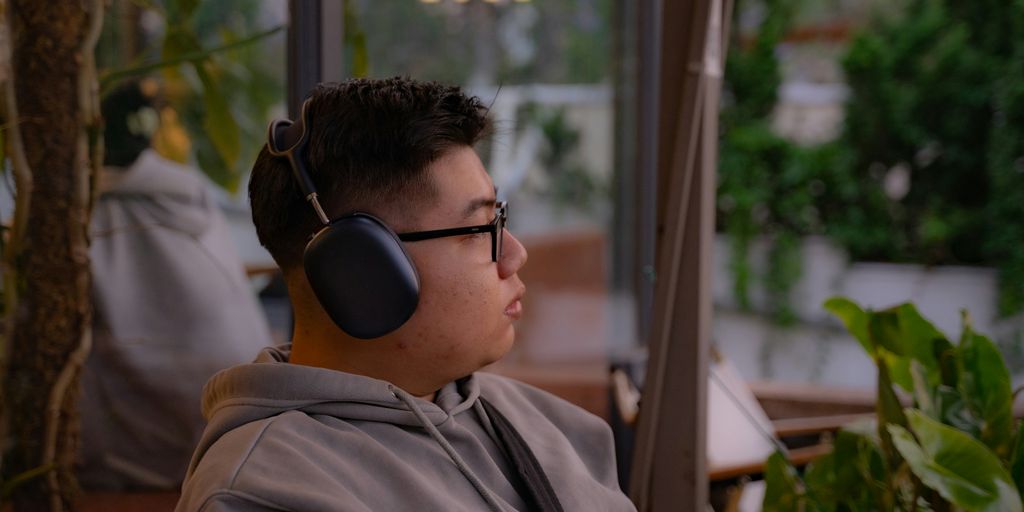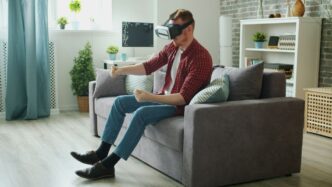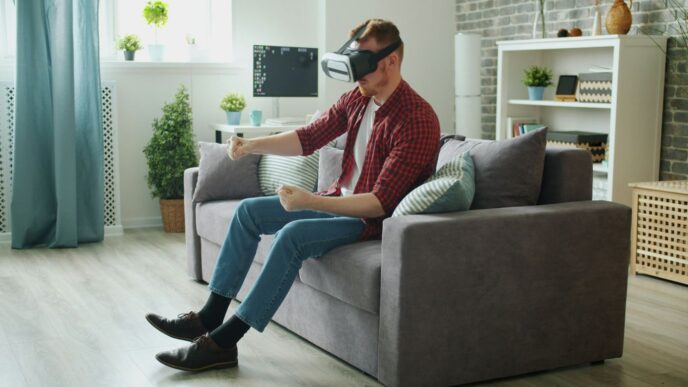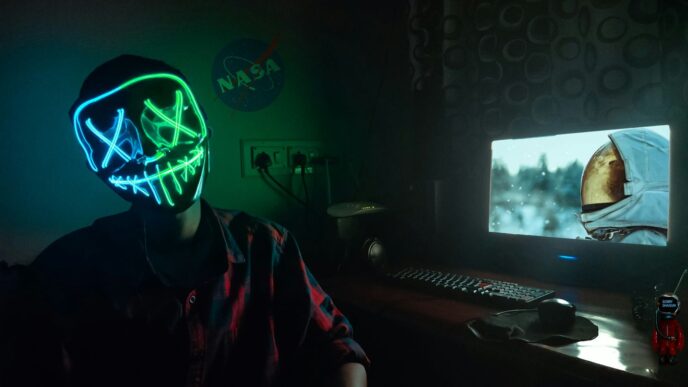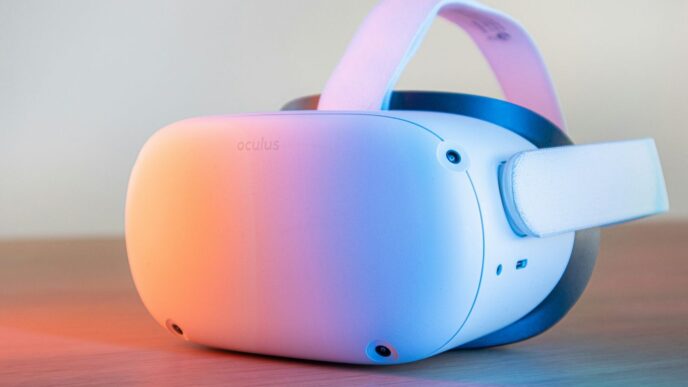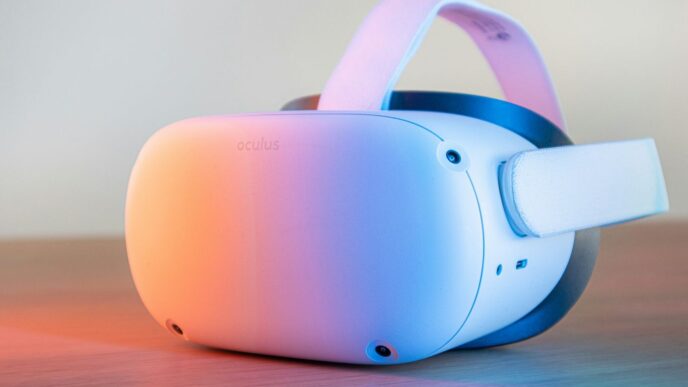So, you’ve got a VR headset and you’re wondering how to watch movies in virtual reality. It’s not quite like sitting on your couch, but it can be pretty cool. Think of it as a personal cinema, but way more advanced. We’re going to break down what you need to know, from picking the right movie to making sure your setup is comfy. Let’s get you ready for your first VR movie night.
Key Takeaways
- Virtual reality movies immerse you in a computer-generated 3D world, often using a headset for a more engaging experience than traditional films.
- You can access movies in VR through native apps on streaming services like Netflix and Prime Video, rent them via platforms like YouTube, or use VR browsers for services without dedicated apps.
- Setting up your viewing space involves choosing a comfortable, well-lit area and considering factors like lighting and ambiance for a better experience.
- VR filmmaking involves unique techniques in storytelling, camera work, and sound design to create an immersive experience, differing from standard movie production.
- Potential downsides to VR movies include motion sickness, the cost of equipment, limited content availability, and potential technical glitches.
Understanding Virtual Reality Cinema
Virtual reality cinema is a pretty wild concept, right? Instead of just watching a movie, you’re kind of in it. It’s not like your usual movie-watching setup where you’re just looking at a screen. VR aims to put you right into the middle of the action, making you feel like you’re actually there. Think of it as stepping through the screen and into the story itself. This whole experience is built around something called an ‘experiential interface’. That’s a fancy way of saying you’re not just observing; you’re meant to interact and feel present in the digital world the filmmakers created. It’s a big shift from how we’ve traditionally consumed movies.
What is Virtual Reality?
So, what exactly is virtual reality? At its core, it’s a computer-generated, 3D environment that you can explore. But the key difference from just watching a 3D movie is how you experience it. Instead of just looking at something, VR is designed for you to actively participate and feel like you’re part of it. You usually do this by wearing a headset that shows you the virtual world. Sometimes, you might also use controllers or gloves to interact with things in that digital space. It’s all about making you feel like you’ve been transported somewhere else entirely.
The Experiential Interface in VR
This ‘experiential interface’ is what makes VR so different. It’s the whole system that allows you to feel present and interact within the virtual environment. Unlike a regular movie where you’re a passive observer, VR wants you to be an active participant. You might be able to look around freely, move within a limited space, or even interact with objects or characters. This direct engagement is what creates a much deeper sense of immersion. It’s the difference between looking at a picture of a place and actually feeling like you’re standing there.
Immersive Storytelling Techniques
Filmmakers use specific techniques to make VR stories feel so real. Because you can look anywhere, they have to think differently about how they tell a story. They can’t just rely on cuts or camera angles to direct your attention like in a normal film. Instead, they might use:
- Sound cues: A sound coming from a specific direction can naturally draw your gaze.
- Visual focus points: Bright lights or moving objects can guide your eyes to important parts of the scene.
- Character interaction: Characters might look directly at you or approach you, making you feel involved.
These methods help guide you through the narrative without breaking the illusion that you’re actually in the story’s world. It’s a whole new way of thinking about how to get a story across.
Choosing Your VR Viewing Experience
So, you’ve got your VR headset, and you’re ready to watch some movies. But where do you even start? It’s not quite like just popping in a DVD, you know? There are a few different ways to get your cinematic fix in virtual reality, and each has its own little quirks.
Accessing Streaming Services
This is probably the easiest route for most people. Services like Netflix and Amazon Prime Video have their own apps you can download right onto your VR headset. It’s pretty straightforward: download the app, log in with your existing account, and boom, you’re watching movies in a virtual living room or cinema. It feels a bit like watching on a giant screen, but you’re still in your own space. It’s a good way to catch up on stuff you already have access to.
Renting Movies for VR
If you’re looking for something newer or a specific film that’s not on your usual streaming service, renting is an option. Platforms like YouTube let you rent movies, and you can watch them through their VR app. It might take an extra step or two compared to the native streaming apps, but it’s not too complicated. You just find the movie, rent it, and then watch it within the VR environment. It’s a solid way to get access to a wider selection.
Utilizing VR Browsers
For the more adventurous, or if you have video files saved on your computer, a VR browser can be your best friend. Apps like Bigscreen let you stream content from your PC directly into VR. This takes a little more setup, like getting a remote desktop client going, but it’s totally worth it if you have a personal movie library. You can even watch movies with friends in shared virtual spaces. It’s a bit more involved, but it opens up a lot of possibilities for what you can watch and how you watch it.
Optimizing Your Viewing Environment
Setting up your space for VR movie watching is more than just finding a spot to sit. It’s about creating an environment that lets you get lost in the film without distractions. Think about where you’ll be putting on your headset. A big, open area is usually best, giving you room to move a bit if the experience calls for it, though some films might work better in a cozier, darker setting. It really depends on the movie’s vibe.
Consider the lighting. While you don’t want direct sunlight glaring on your headset screen, a completely pitch-black room can sometimes feel a bit too isolating. A little ambient light can actually help you feel more grounded. Also, think about comfort. You’ll be wearing a headset for a while, so make sure your seating is good. Maybe a comfy couch or a supportive chair is the way to go. You don’t want to be fidgeting or getting stiff halfway through the movie. It’s all about making the experience as smooth and enjoyable as possible, letting the film take center stage.
Here are a few things to keep in mind:
- Clear your space: Remove any tripping hazards like rugs, cables, or furniture you might bump into. You want to avoid any unexpected real-world interruptions.
- Manage ambient noise: While VR headsets do a decent job of blocking out sound, loud external noises can still break the immersion. Try to pick a time when your home is quieter, or consider using headphones with your headset for better audio isolation.
- Check your temperature: Being too hot or too cold can be distracting. Make sure the room is at a comfortable temperature before you start your movie.
Navigating VR Content and Platforms
So, you’ve got your headset on, and you’re ready to watch something. But where do you actually find movies made for VR, or just regular movies you can watch in your virtual space? It can feel a bit like a treasure hunt at first, but there are a few main ways to go about it.
Exploring VR Video Apps
Lots of companies have made apps specifically for watching videos in VR. Think of them like your own personal movie theaters or even virtual living rooms. You can find apps that offer a huge variety of content, from short 360-degree clips to full-length films. Some apps focus on documentaries and travel, while others are all about entertainment and sports. It’s a good idea to check out a few different ones to see what kind of library they have. For example, apps like Littlstar VR Cinema give you access to content from big names like ABC and Discovery, which is pretty neat.
Discovering VR Cinema Producers
Beyond the big apps, there are also creators who specialize in making VR movies. These folks are often pushing the boundaries of what’s possible in virtual storytelling. You might find their work through specific VR platforms or sometimes even directly on sites like YouTube if they upload 360-degree content. Some studios are even focusing on creating entire VR feature films. If you’re interested in how these experiences are made, you might find resources from places like Vancouver Film School helpful.
Experiencing Interactive VR Narratives
This is where things get really interesting. Some VR content isn’t just something you watch; it’s something you participate in. These are interactive narratives where your choices or movements can actually affect the story. Imagine being able to look around a scene and trigger new information or even change the direction of the plot. It’s a different kind of movie-watching, more like being inside the story itself. These experiences often blend traditional filmmaking with game-like elements, offering a unique way to engage with a story.
Technical Considerations for VR Viewing
So, you’ve got your VR headset, and you’re ready to dive into a movie. But wait, there are a few technical things to sort out before you get too comfortable. It’s not quite as simple as just hitting play on your TV, you know?
Understanding Headset Requirements
First off, not all VR headsets are created equal when it comes to watching movies. You’ll want to check what kind of resolution your headset offers. A lower resolution can make text hard to read and details fuzzy, which really takes away from the experience. Also, consider the field of view – a wider view feels more natural and less like you’re looking through binoculars. Some headsets are better suited for gaming, with high refresh rates that might be overkill for a movie, while others are designed with comfort and visual clarity for longer viewing sessions in mind. It’s worth looking into:
- Screen Resolution: Measured in pixels per eye (e.g., 1832×1920 per eye). Higher is generally better for clarity.
- Field of View (FOV): How wide your view is. A wider FOV (around 100-110 degrees) feels more immersive.
- Refresh Rate: How smoothly the image updates. While important for gaming, 60-90Hz is usually fine for movies.
- Comfort and Fit: How it feels on your face for extended periods. Adjustable straps and weight distribution matter.
Troubleshooting Common Issues
Even with the right gear, things can go wrong. You might run into tracking problems where the headset loses its place, or maybe the video itself stutters. Sometimes, it’s just a matter of restarting the headset or the app you’re using. Other times, it could be your internet connection if you’re streaming. If the picture looks distorted, check if the lenses are clean and properly adjusted for your eyes. A lot of these issues are pretty common, and usually, a quick search online for your specific headset model and the problem will give you a solution.
Managing Space and Movement
Unlike sitting on a couch, VR often requires a bit of physical space. While watching a movie, you might not need a huge area, but you still need to be aware of your surroundings. If the movie has interactive elements or if you tend to move around a lot, you’ll want a clear space to avoid bumping into furniture or walls. Some VR movie apps might even have a ‘guardian’ system that warns you if you’re getting too close to the edge of your play area. For a passive movie experience, you can often get away with just sitting or standing in one spot, but it’s always good to have a little buffer zone just in case.
The Art of VR Filmmaking
Making movies for virtual reality is a bit different from what you might be used to. It’s not just about pointing a camera and hitting record; you have to think about how the viewer will actually be there. This means rethinking how you tell a story.
Crafting Compelling Storylines
When you’re making a VR film, the story needs to be built with the immersive experience in mind from the start. Think about settings that really benefit from a 360-degree view. Places like vast landscapes, outer space, or even a spooky forest can be amazing in VR. Don’t just copy what others have done; try to come up with something fresh. The goal is to make the audience feel like they’ve stepped into another world, not just watched a screen.
Strategic Camera Placement and Movement
Camera work in VR is all about perspective. You can’t just cut away to a different angle like in a regular movie. Instead, you need to think about where the viewer’s attention will naturally go. Using natural light or practical lighting on set can really help make the scene feel more real. Camera movement needs to make sense with the story. A slow pan, for instance, can build suspense, but it has to feel right for the scene. It’s a balancing act between guiding the viewer and letting them explore.
Mastering Sound Design for Immersion
Sound is a huge part of making VR feel real. You’ve got to consider both the sounds that are part of the story (diegetic sound) and the music or narration that isn’t (non-diegetic sound). Because the viewer can look anywhere, sound needs to help direct them. If something important happens off to the side, the sound should cue the viewer to look there. Traditional boom mics might not always work, so you might need different approaches, like lavalier mics. Getting the sound right in post-production is key to making the whole experience believable.
Potential Challenges of VR Movies
While VR movies offer a unique way to experience stories, there are definitely some bumps in the road that can make watching them a bit tricky. It’s not always smooth sailing, and people run into a few common problems.
Addressing Motion Sickness
One of the biggest issues people talk about is motion sickness, sometimes called "cybersickness." It’s that queasy, dizzy feeling you can get when your eyes see movement in VR, but your body doesn’t feel like it’s actually moving. This can lead to headaches and just feeling generally off. It really depends on the person and how the movie is made. Some films are better at avoiding this than others.
Managing High Costs and Accessibility
Getting into VR movies isn’t exactly cheap. You need a VR headset, and those can cost a pretty penny. Plus, the computers or phones that can run them smoothly also add to the expense. This means VR movies aren’t something everyone can easily jump into right away. It’s a bit of a barrier for entry, making it less accessible than just popping on a regular movie on your TV.
Overcoming Limited Content Availability
Because VR is still pretty new, there just aren’t as many movies made specifically for it compared to the vast libraries of traditional films. You might find yourself searching for a while to find something new to watch. While the number of VR films is growing, it’s still a small pond compared to the ocean of regular movies out there. This can be a bit disappointing if you’re looking for a lot of variety.
The Future of Film is Here
So, there you have it. Watching movies in VR might seem a bit different from your usual movie night, but it’s really not that complicated once you get the hang of it. Whether you’re using a headset for the first time or you’re a seasoned VR user, there are tons of ways to enjoy films in this new way. It’s a cool experience that can make you feel like you’re right there in the movie. Give it a try, and who knows, you might just find your new favorite way to watch movies.
Frequently Asked Questions
What exactly is virtual reality (VR)?
Virtual reality, or VR, is like stepping into a computer-generated world. Instead of just looking at a screen, you wear a special headset that makes you feel like you’re really there. You can often interact with things in this digital place, making the experience much more engaging than just watching a regular movie.
How does watching a movie in VR feel different from a normal movie?
Watching movies in VR usually means you’ll be in a virtual space, like a comfy room or a movie theater, with a big screen in front of you. Your VR headset shows you this screen, and you can often look around the virtual room while you watch. It’s like having your own private cinema!
Where can I find movies to watch in VR?
You can watch VR movies through special apps on your VR headset, like Netflix or Prime Video, which have their own VR versions. You can also rent movies through apps like YouTube or Bigscreen, or even use a VR web browser to visit streaming sites that don’t have a VR app yet. Some people also stream movies from their own computers.
Can VR movies make me feel sick?
Some people might feel a bit dizzy or queasy, kind of like when you get car sick, when using VR. This is called motion sickness. It’s a good idea to start with shorter viewing times and take breaks if you feel uncomfortable. Making sure your VR setup is smooth and doesn’t have jerky movements can also help a lot.
Are VR movies expensive and is there much content available?
While VR can be amazing, the headsets and other gear can be pretty expensive. Also, there aren’t as many movies made specifically for VR compared to regular movies right now. But, more content is being made all the time, and prices for VR gear are slowly coming down.
How do filmmakers make VR movies so immersive?
Yes! VR movies can make you feel like you’re actually in the story. Filmmakers use special camera tricks and sound design to pull you in. For example, they might place the camera in a spot that feels natural or use sounds that make you feel like you’re right there with the characters.


